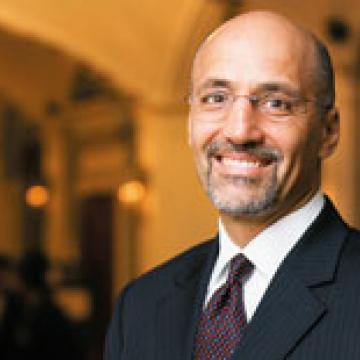From the director: A failed first year? Think again
One of President Trump's successes has been greatly expanding the reach of the federal government
As we approach the end of President Trump’s first year in office, the assessments will begin to roll in. Expect full reviews of the president’s Twitter taunts, his low popularity, his campaign’s ties to Russia, and (perhaps related to all three) his struggles to move a legislative agenda through a GOP-controlled Congress.
A failed first year? Think again. In an important recent article, UVA Miller Center’s Sidney Milkis, along with Nicholas Jacobs, argue that the president has exhibited greater success than is generally believed. Their article was recently featured by Dan Balz, the chief correspondent for the Washington Post.
Trump’s successes come from using executive action—a trend continued and accelerated by President Obama—to the great consternation of many conservatives.
Sidney and Nicholas show how the “administrative presidency” has assumed greater power, as Congress stands and watches. Rather than dismantle the administrative state (as Steve Bannon once boasted), the Trump administration is building and using it aggressively: by stepping up deportations of illegal immigrants, promoting coal and oil-and-gas exploration, prodding states to take responsibility for Medicare and Medicaid, and proposing dramatic funding increases for the defense department.
Sidney and Nicholas also outline how the president has simply taken advantage of a system of “executive-centered partisanship.” The nation is more polarized politically, but the two main parties have less control over their elected representatives, particularly when it comes to moving legislation. Grass-roots movements, independent political committees, and a splintering media environment have made congressional politics more conflictual and less prone to compromise.
That leaves the field clear for a president to act unilaterally—and expand the reach of the federal government.
Obama experienced this in his own first year struggle to pass the Affordable Care Act, despite the fact that his own party controlled both houses of Congress. He experienced it again in subsequent years when he tried to work with a GOP congress to pass any number of laws—from a balanced budget agreement to immigration reform. When the latter effort failed, he simply went it alone.
Trump has continued that trend. Of course, there is a deep irony in this. Small-government conservative activists, embodied by the Tea Party, may have led to a big-government conservative president. The Tea Party movement provoked a surge of conservative activism and anger toward Washington that overwhelmed the more traditional GOP establishment. This anger had started against George W. Bush’s expansion of health care (prescription drug benefits) and education (No Child Left Behind). It extended to the Obama administration’s massive recovery response, auto and bank bailouts (with additional regulations in both areas), and then passage of Obamacare.
Trump has capitalized on the anger of that movement, yet he’s done so to advance an agenda that is no more small-government than that of his two predecessors.
No assessment of Trump’s first year would be complete without understanding how he is using the federal government to advance his agenda. Quite the opposite of LBJ’s standard—which held that a president had one year to work with Congress—Trump seems to have decided from the beginning that Congress was going to be an unreliable partner at best.
The deepest irony of all may come next year in the midterm elections. Whether Congress passes tax reform or not, the president’s agenda and style may have so alienated voters that they blame a GOP Congress—for enabling Trump, for failing to work with him, or for both. Trump might then discover that a GOP Congress wasn’t so bad after all.
